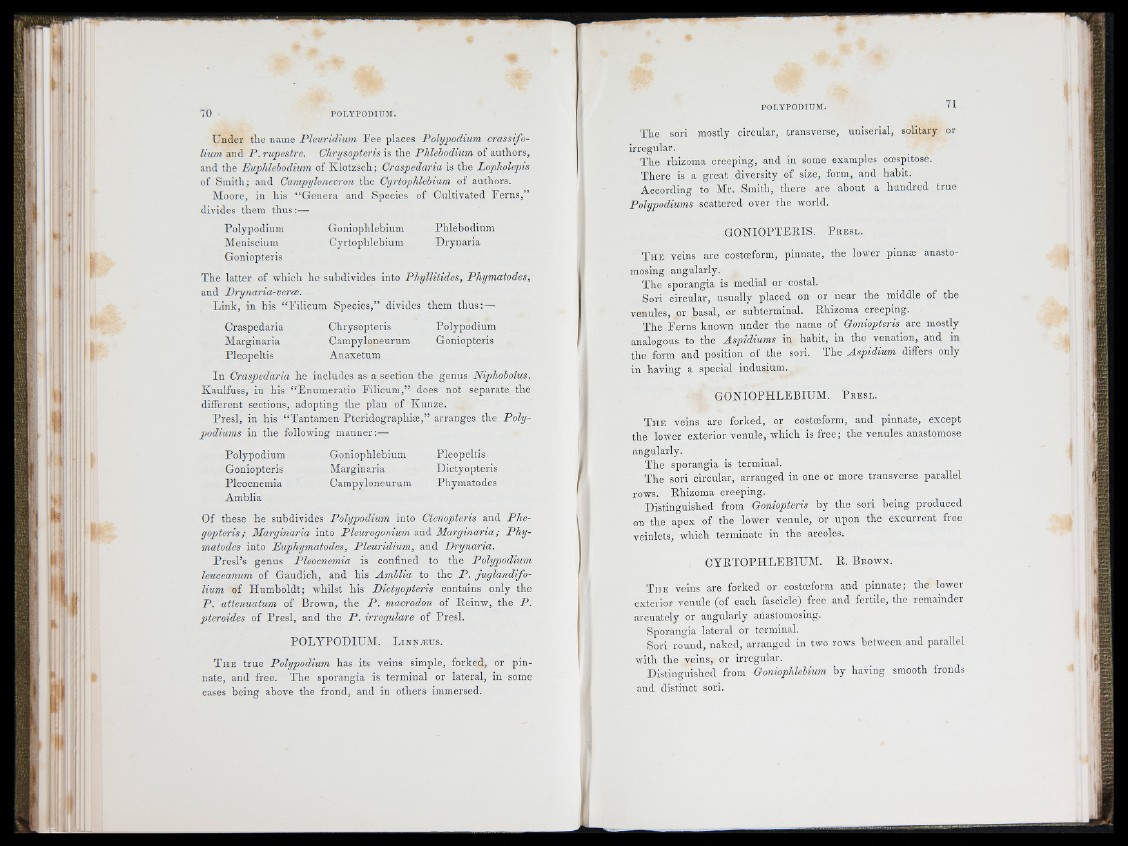
70 PO L Y P O D IU M .
ITuder the name r ie u r id ium Fee places Polypodium crassifo-
lium and P . rupestre. Clirysopteris is the Phlehodium of authors,
and the Etiphlehodium of Klotzsch; Craspedaria is the Lopholepis
of Sm ith ; and Campyloncvro/i the Cyrtophlebium of authors.
Moore, iu his “ Genera and Species of Cultivated F e rn s,”
divides them th u s :—
Polypodium Goniophlebium Phlebodium
IMeniscium Cyrtophlebium D ry n a ria
Goniopteris
T he latter of which he subdivides into P h y llitid e s, Phymatodes,
and Prynaria-verm.
L in k , in his “ Pilicum Species,” divides them th u s; —
Craspedaria Chrysoptcris Polypodium
Ma rginaria Campyloneurum Goniopteris
Pleopeltis Anaxetum
In Craspedaria he includes as a section the genus Niphobolus.
Kaulfuss, iu his “ E nume ratio Filicum,” does not separate the
different sections, adopting the plan of Kunze.
Pre sl, in his “ Tantamen Pterid o g rap h ia ;,” arranges the P oly -
podiums in the following man n e r;—
Polypodium
Goniopteris
Pleocnemia
Amhlia
Goniophlebium
Marginaria
Campyloneurum
Pleopeltis
Dictyopteris
Phymatodes
Of these he subdivides Polypodium into Ctenopteris and P h e gopteris;
Marginaria into Pleurogonium and M a rg in a ria ; P h y matodes
into E uphymatodes, P le u rid ium , and Dryn a ria .
P re s l’s genus Pleocnemia is confined to the P olypodium
leuceanum of Gaudich, and his Am b lia to the P . ju g la n d ifo -
lium of H um b o ld t; whilst his Dictyopteris contains only the
P . attenuatum of Brown, the P . macrodon of E einw, the P .
pteroides of P re sl, and th e P . irreguläre of Presl.
PO L Y PO D IUM . LiNNiBus.
T h e tru e Polypodium has its veins simple, forked, or p in nate,
and free. The sporangia is termina l or lateral, in some
cases being above the frond, and in others immersed.
The sori mostly circular, transverse, unisorial, solitary or
irregular.
The rliizoma creeping, and in some examples coespitose.
There is a gre a t diversity of size, form, and habit.
According to Mr. Smith, there are about a h u n d red tru e
Polypodiums scattered over the world.
G O N IO P T E R IS . P r e s l .
T h e veins are costæform, pinnate, the lower pinnæ anastomosing
angularly.
T he sporangia is medial or costal.
Sori circular, usually placed on or near the middle of the
venules, or basal, or suhterminal. Rhizoma creeping.
T h e P e rn s known un d e r the name of Goniopteris are mostly
analogous to the A sp id ium s in h abit, in the venation, and in
the form and position of the sori. The A sp id ium differs only
in having a special indusium.
G O N IO P H L E B IU M . P r e s l .
T h e veins are forked, or costæform, and pinnate, except
the lower exterior venule, which is fre e ; the venules anastomose
angularly.
T h e sporangia is terminal.
The sori circular, arranged in one or more transverse parallel
rows. Rhizoma creeping.
Distinguished from Goniopteris by the sori being produced
on the apex of the lower venule, or upon the ex cu rren t free
veinlets, which terminate in the areoles.
C Y R T O P H L E B IU M . R. B r o w n .
T h e veins are forked or costæform and pinnate; the lower
exterior venule (of each fascicle) free and fertile, the remainder
arcuatcly or angularly anastomosing.
Sporangia lateral or terminal.
Sori round, naked, arranged in two rows between and parallel
with the veins, or irreg u la r.
D istinguished from Goniophlebium by having smooth fronds
and distinct sori.